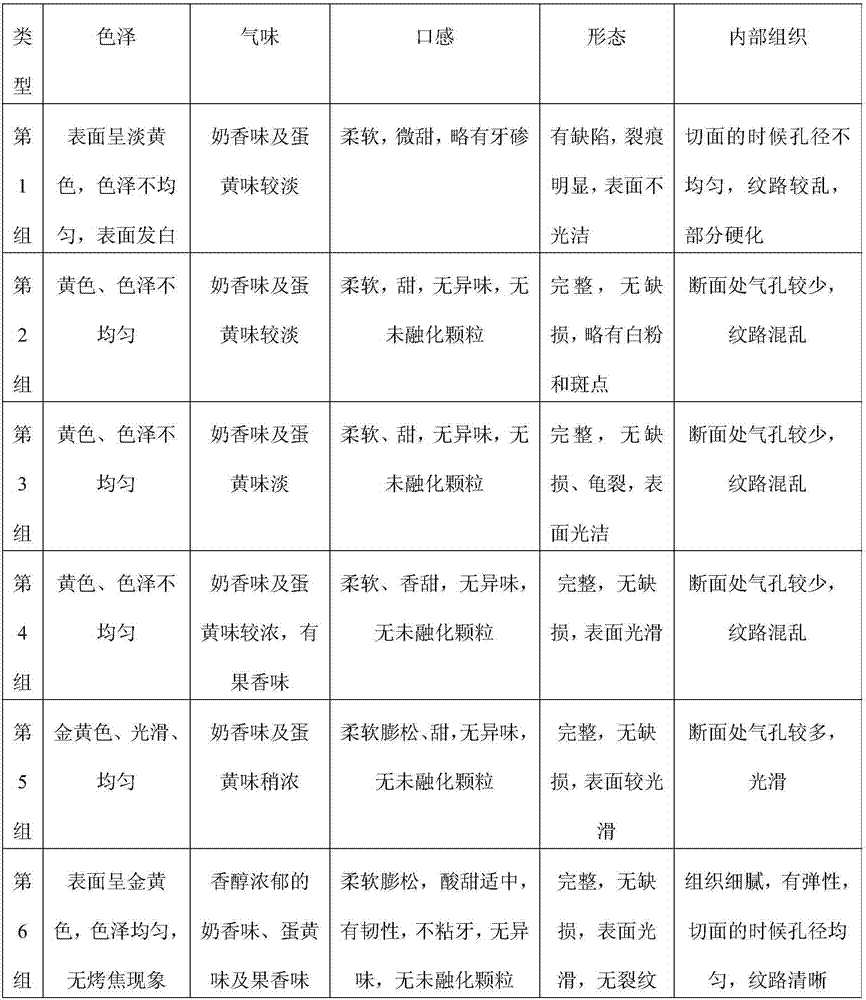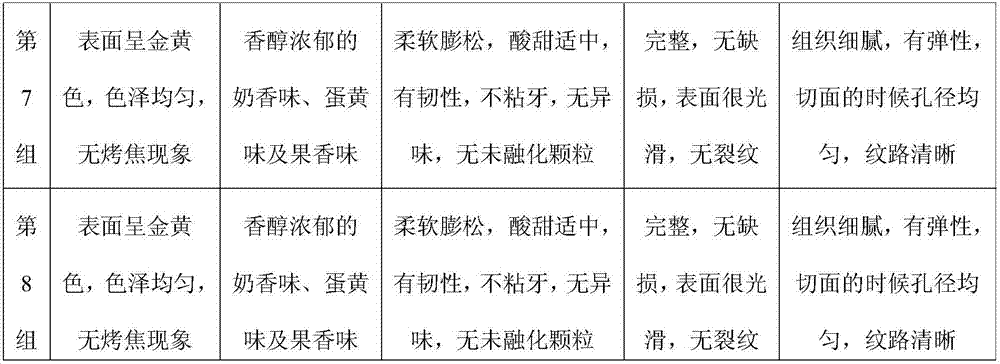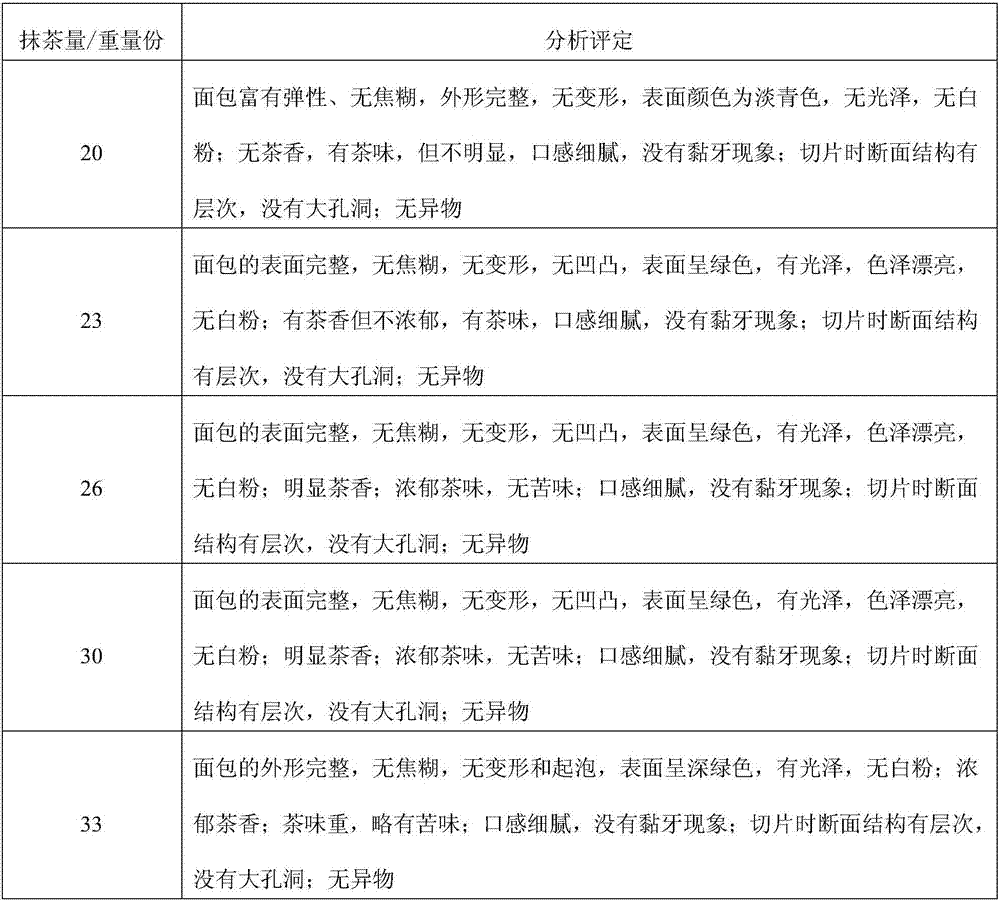Matcha bread and producing method thereof
A production method and bread technology, applied in the field of food processing, can solve the problems of short shelf life and incomplete nutrition, achieve long shelf life, promote gastrointestinal absorption, and taste sweet and delicious
- Summary
- Abstract
- Description
- Claims
- Application Information
AI Technical Summary
Problems solved by technology
Method used
Image
Examples
Embodiment 1
[0029] A matcha bread, mainly made of the following raw materials in parts by weight: 80 parts of high-gluten flour, 25 parts of matcha powder, 17 parts of soybean powder, 15 parts of gluten powder, 10 parts of bitter gourd powder, 20 parts of stevia powder, and 13 parts of hawthorn powder , 3 parts of tortoise powder, 3 parts of lemongrass powder, 3 parts of blue eucalyptus powder, 3 parts of acacia bud powder, 15 parts of plum juice, 15 parts of plum juice, 1 part of ammonium chloride, 1 part of ammonium carbonate, distilled monostearin 1.5 parts of glyceride, 0.5 part of cephalin, 0.3 part of sodium propionate, 0.5 part of heme iron, 0.5 part of casein phosphopeptide, 0.5 part of maltol, 1 part of active dry yeast, 20 parts of mirror pectin, 5 parts of sucrose , 5 parts of maltose, 3 parts of eggs, 20 parts of milk powder, 6 parts of butter, 3 parts of sesame oil, 3 parts of rice bran oil, 5 parts of salt and 35 parts of water;
[0030] Mirror pectin is mainly made of the f...
Embodiment 2
[0043] A matcha bread, mainly made of the following raw materials by weight: 90 parts of high-gluten flour, 27 parts of matcha powder, 18.5 parts of soybean powder, 17 parts of gluten powder, 11.5 parts of bitter gourd powder, 21.5 parts of stevia powder, and 14 parts of hawthorn powder , 3.5 parts of tortoise powder, 3.5 parts of lemongrass powder, 3.5 parts of blue eucalyptus powder, 3.5 parts of pagoda flower bud powder, 16 parts of plum juice, 16 parts of plum juice, 1.3 parts of ammonium chloride, 1.5 parts of ammonium carbonate, distilled monostearin 1.7 parts of acid glycerides, 0.7 parts of cephalin, 0.4 parts of sodium propionate, 0.6 parts of heme iron, 0.6 parts of casein phosphopeptide, 0.6 parts of maltol, 1.5 parts of active dry yeast, 25 parts of mirror pectin, 6 parts of sucrose , 6 parts of maltose, 3.5 parts of eggs, 23 parts of milk powder, 8 parts of butter, 4 parts of sesame oil, 4 parts of rice bran oil, 7 parts of salt and 40 parts of water;
[0044] Mir...
Embodiment 3
[0057] A matcha bread, mainly made of the following raw materials in parts by weight: 100 parts of high-gluten flour, 30 parts of matcha powder, 20 parts of soybean powder, 20 parts of gluten powder, 13 parts of bitter gourd powder, 23 parts of stevia powder, and 15 parts of hawthorn powder , 4 parts of tortoise powder, 4 parts of lemongrass powder, 4 parts of blue eucalyptus powder, 4 parts of sophora bud powder, 17 parts of plum juice, 17 parts of plum juice, 1.5 parts of ammonium chloride, 2 parts of ammonium carbonate, distilled monostearin 2 parts glycerides, 1 part cephalin, 0.5 parts sodium propionate, 0.7 parts heme iron, 0.7 parts casein phosphopeptide, 0.7 parts maltol, 2 parts active dry yeast, 30 parts mirror pectin, 7 parts sucrose , 7 parts of maltose, 4 parts of eggs, 25 parts of milk powder, 10 parts of butter, 5 parts of sesame oil, 5 parts of rice bran oil, 10 parts of salt and 45 parts of water;
[0058] Mirror pectin is mainly made of the following raw mate...
PUM
 Login to View More
Login to View More Abstract
Description
Claims
Application Information
 Login to View More
Login to View More - R&D
- Intellectual Property
- Life Sciences
- Materials
- Tech Scout
- Unparalleled Data Quality
- Higher Quality Content
- 60% Fewer Hallucinations
Browse by: Latest US Patents, China's latest patents, Technical Efficacy Thesaurus, Application Domain, Technology Topic, Popular Technical Reports.
© 2025 PatSnap. All rights reserved.Legal|Privacy policy|Modern Slavery Act Transparency Statement|Sitemap|About US| Contact US: help@patsnap.com



